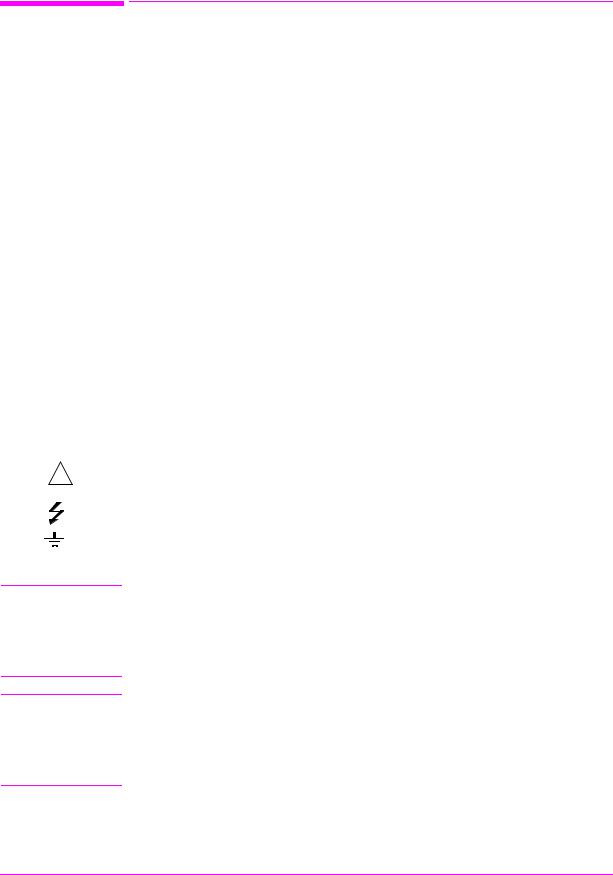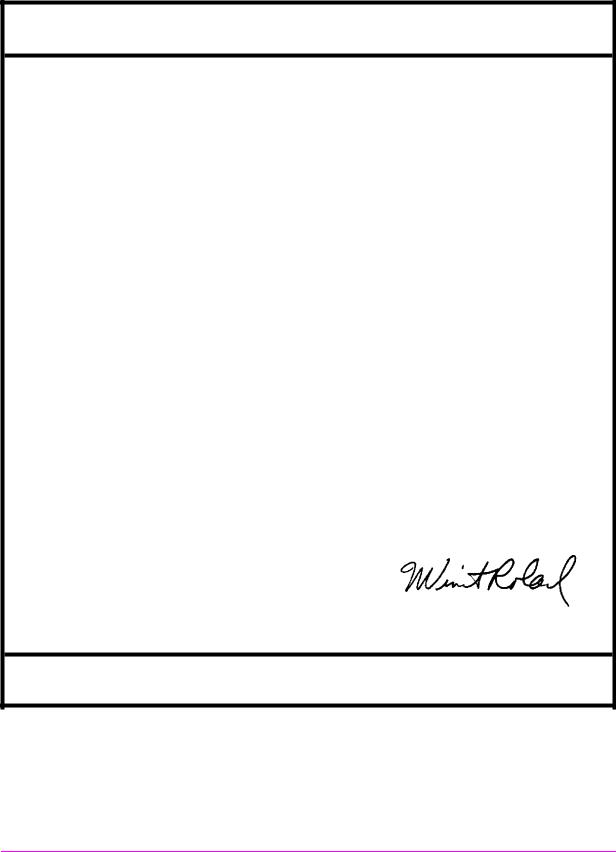HP TIA-EIA-136, 83206A User Manual

HP 83206A
TIA/EIA-136 Cellular Adapter
User’s Guide
HP Part Number 83206-90002
Revision H
Printed in U.S.A.
October 1999
© Copyright Hewlett-Packard Company, 1998

Notice
Information contained in this document is subject to change without notice.
All Rights Reserved. Reproduction, adaptation, or translation without prior written permission is prohibited, except as allowed under the copyright laws.
This material may be reproduced by or for the U.S. Government pursuant to the Copyright License under the clause at DFARS 52.227-7013 (APR 1988).
Hewlett-Packard Company
Education Tools Department
24001 E. Mission
Liberty Lake, WA 99019-9599
U.S.A.
2

Manufacturer’s Declaration
This statement is provided to comply with the requirements of the
German Sound Emission Directive, from 18 January 1991.
This product has a sound pressure emission (at the operator position) < 70 dB(A).
•Sound Pressure Lp < 70 dB(A).
•At Operator Position.
•Normal Operation.
•According to ISO 7779:1988/EN 27779:1991 (Type Test).
Herstellerbescheinigung
Diese Information steht im Zusammenhang mit den Anforderungen der Maschinenlärminformationsverordnung vom 18 Januar 1991.
•Schalldruckpegel Lp < 70 dB(A).
•Am Arbeitsplatz.
•Normaler Betrieb.
•Nach ISO 7779:1988/EN 27779:1991 (Typprüfung).
3

Safety Considerations
GENERAL
This product and related documentation must be reviewed for familiarization with safety markings and instructions before operation.
This product has been designed and tested in accordance with IEC Publication 1010, "Safety Requirements for Electronic Measuring Apparatus," and has been supplied in a safe condition. This instruction documentation contains information and warnings which must be followed by the user to ensure safe operation and to maintain the product in a safe condition.
SAFETY EARTH GROUND
A uninterruptible safety earth ground must be provided from the main power source to the product input wiring terminals, power cord, or supplied power cord set.
CHASSIS GROUND TERMINAL
To prevent a potential shock hazard, always connect the rear-panel chassis ground terminal to earth ground when operating this instrument from a dc power source.
SAFETY SYMBOLS
!
WARNING
Indicates instrument damage can occur if indicated operating limits are exceeded. Refer to the instructions in this guide.
Indicates hazardous voltages.
Indicates earth (ground) terminal
A WARNING note denotes a hazard. It calls attention to a procedure, practice, or the like, which, if not correctly performed or adhered to, could result in personal injury. Do not proceed beyond a WARNING sign until the indicated conditions are fully understood and met.
CAUTION
A CAUTION note denotes a hazard. It calls attention to an operation procedure, practice, or the like, which, if not correctly performed or adhered to, could result in damage to or destruction of part or all of the product. Do not proceed beyond an CAUTION note until the indicated conditions are fully understood and met.
4

Safety Considerations for this Instrument
WARNING |
This product is a Safety Class I instrument (provided with a |
|
protective earthing ground incorporated in the power cord). |
|
The mains plug shall only be inserted in a socket outlet |
|
provided with a protective earth contact. Any interruption of |
|
the protective conductor inside or outside of the product is |
|
likely to make the product dangerous. Intentional interruption |
|
is prohibited. |
|
Whenever it is likely that the protection has been impaired, the |
|
instrument must be made inoperative and be secured against |
|
any unintended operation. |
|
If this instrument is to be energized via an autotransformer (for |
|
voltage reduction), make sure the common terminal is |
|
connected to the earth terminal of the power source. |
|
If this product is not used as specified, the protection provided |
|
by the equipment could be impaired. This product must be used |
|
in a normal condition (in which all means for protection are |
|
intact) only. |
|
No operator serviceable parts in this product. Refer servicing |
|
to qualified personnel. To prevent electrical shock, do not |
|
remove covers. |
|
Servicing instructions are for use by qualified personnel only. |
|
To avoid electrical shock, do not perform any servicing unless |
|
you are qualified to do so. |
|
The opening of covers or removal of parts is likely to expose |
|
dangerous voltages. Disconnect the product from all voltage |
|
sources while it is being opened. |
|
Adjustments described in the manual are performed with |
|
power supplied to the instrument while protective covers are |
|
removed. Energy available at many points may, if contacted, |
|
result in personal injury. |
|
The power cord is connected to internal capacitors that my |
|
remain live for 5 seconds after disconnecting the plug from its |
|
power supply. |
|
For Continued protection against fire hazard, replace the line |
5

fuse(s) only with 250 V fuse(s) or the same current rating and type (for example, normal blow or time delay). Do not use repaired fuses or short circuited fuseholders.
6

CAUTION Always use the three-prong ac power cord supplied with this product. Failure to ensure adequate earth grounding by not using this cord may cause product damage.
This product is designed for use in Installation Category II and Pollution Degree 2 per IEC 1010 and IEC 664 respectively. For indoor use only.
This product has autoranging line voltage input, be sure the supply voltage is within the specified range.
Ventilation Requirements: When installing the product in a cabinet, the convection into and out of the product must not be restricted. The ambient temperature (outside the cabinet) must be less than the maximum operating temperature of the product by 4° C for every 100 watts dissipated in the cabinet. If the total power dissipated in the cabinet is greater than 800 watts, then forced convection must be used.
Product Markings
CE - the CE mark is a registered trademark of the European Community. A CE mark accompanied by a year indicated the year the design was proven.
CSA - the CSA mark is a registered trademark of the Canadian
Standards Association.
7

Hewlett-Packard Warranty Statement for Commercial Products
HP 83206A TIA/EIA-136 Cellular Adapter
Duration of Warranty: One Year
1.HP warrants HP hardware, accessories and supplies against defects in materials and workmanship for the period specified above. If HP receives notice of such defects during the warranty period, HP will, at its option, either repair or replace products which prove to be defective. Replacement products may be either new or like-new.
2.HP warrants that HP software will not fail to execute its programming instructions, for the period specified above, due to defects in material and workmanship when properly installed and used. If HP receives notice of such defects during the warranty period, HP will replace software media which does not execute its programming instructions due to such defects.
3.HP does not warrant that the operation of HP products will be uninterrupted or error free. If HP is unable, within a reasonable time, to repair or replace any product to a condition as warranted, customer will be entitled to a refund of the purchase price upon prompt return of the product.
4.HP products may contain remanufactured parts equivalent to new in performance or may have been subject to incidental use.
5.The warranty period begins on the date of delivery or on the date of installation if installed by HP. If customer schedules or delays HP installation more than 30 days after delivery, warranty begins on the 31st day from delivery.
6.Warranty does not apply to defects resulting from (a) improper or inadequate maintenance or calibration, (b) software, interfacing, parts or supplies not supplied by HP, (c) unauthorized modification or misuse, (d) operation outside of the published environmental specifications for the product, or (e) improper site preparation or maintenance.
7.TO THE EXTENT ALLOWED BY LOCAL LAW, THE ABOVE WARRANTIES ARE EXCLUSIVE AND NO OTHER WARRANTYOR CONDITION, WHETHER WRITTEN OR ORAL IS EXPRESSED OR IMPLIED AND HP SPECIFICALLY DISCLAIMS ANY IMPLIED WARRANTIES OR CONDITIONS OR MERCHANTABILITY, SATISFACTORY QUALITY, AND FITNESS FOR A PARTICULAR PURPOSE.
8

8.HP will be liable for damage to tangible property per incident up to the greater of $300,000 or the actual amount paid for the product that is the subject of the claim, and for damages for bodily injury or death, to the extent that all such damages are determined by a court of competent jurisdiction to have been directly caused by a defective HP product.
9.TO THE EXTENT ALLOWED BY LOCAL LAW, THE REMEDIES
IN THIS WARRANTY STATEMENT ARE CUSTOMER’S SOLE AND EXCLUSIVE REMEDIES. EXCEPT AS INDICATED ABOVE, IN NO EVENT WILL HP OR ITS SUPPLIERS BE LIABLE FOR LOSS OF DATA OR FOR DIRECT, SPECIAL, INCIDENTAL, CONSEQUENTIAL (INCLUDING LOST PROFIT OR DATA), OR OTHER DAMAGE, WHETHER BASED IN CONTRACT, TORT, OR OTHERWISE.
FOR CONSUMER TRANSACTIONS IN AUSTRALIA AND NEW ZEALAND: THE WARRANTY TERMS CONTAINED IN THIS STATEMENT, EXCEPT TO THE EXTENT LAWFULLY PERMITTED, DO NOT EXCLUDE RESTRICT OR MODIFY AND ARE IN ADDITION TO THE MANDATORY STATUTORY RIGHTS APPLICABLE TO THE SALE OF THIS PRODUCT TO YOU.
9

DECLARATION OF CONFORMITY
according to ISO/IEC Guide 22 and EN 45014
Manufacturer’s Name:
Manufacturer’s Address:
Hewlett-Packard Co.
Spokane Division
24001 E. Mission Avenue
Liberty Lake, Washington 99019-9599
USA
declares that the product
Product Name:
Model Number:
Product Options:
TIA/EIA-136 Cellular Adapter
HP 83206A
This declaration covers all options of the above product.
conforms to the following Product specifications:
Safety: IEC 1010-1:1990+A1 / EN 61010-1:1993
CAN/CSA-C22.2 No. 1010.1-92
EMC: CISPR 11:1990/EN 55011:1991 Group 1, Class A
IEC 801-2:1984/EN 50082-1:1992 4 kV CD, 8 kV AD IEC 801-3:1984/EN 50082-1:1992 3V/m
IEC 801-4:1988/EN 50082-1:1992 0.5 kV Sig. Lines, 1 kV Power Lines
Supplementary Information:
This product herewith complies with the requirements of the Low Voltage Directive
73/23/EEC and the EMC Directive 89/336/EEC.
Spokane, Washington USA November 20, 1995 |
|
Date |
Vince Roland/Quality Manager |
European Contact: Your local Hewlett-Packard Sales and Service Office or Hewlett-Packard GmbH
Department ZQ/Standards Europe, Herrenberger Strasse 130, D-71034 Bö blinger, Germany (FAX+49-7031-14-3143)
10

Regional Sales and Service Offices
Eastern USA |
Eastern USA |
Midwestern USA |
Sales Office |
Sales Office |
Sales and Service |
Hewlett-Packard Company |
Hewlett-Packard Company |
Hewlett-Packard Company |
2101 Gather Rd. |
2101 Gather Rd. |
5201 Tollview Drive |
Rockville, MD 20850 |
Rockville, MD 20850 |
Rolling Meadows, IL 60008 |
Tel: (301) 258-2000 |
Tel: (301) 258-2000 |
Tel: (708) 342-2000 |
|
|
|
Southern USA |
Southern USA |
Western USA |
Sales and Service |
Service Center |
Service Center |
Hewlett-Packard Company |
Hewlett-Packard Company |
Hewlett-Packard Company |
1995 North Park Place |
930 E. Campbell Road |
301 E. Evelyn Avenue |
Atlanta, GA 30339 |
Richardson, TX 75081 |
Mountain View, CA 94041 |
Sales |
Tel: (214) 699-4331 |
Tel: (415) 694-2000 |
Tel: (404) 955-1500 |
|
Fax: (415) 694-0601 |
Fax: (404) 980-7292 |
|
|
Service |
|
|
Tel: (404) 850-2544 |
|
|
Fax: (404) 980-7292 |
|
|
|
|
|
Western USA |
Western USA |
United States of America |
Sales and Service |
Sales and Service |
Customer Information Center |
Hewlett-Packard Company |
Hewlett-Packard Company |
Hewlett-Packard Company |
24 Inverness Place East |
1421 South Manhattan Avenue |
Tel: (800) 752-0900 |
Englewood, CO 80112 |
Fullerton, CA 92631 |
6:00 am to 5:00 pm Pacific Time |
Sales |
Sales |
Parts Direct: 1-800-227-8164 |
Tel: (303) 649-5000 |
Tel: (714) 999-6700 |
|
Fax: (303) 649-5787 |
Fax: (714) 778-3033 |
|
Service |
Service |
|
Tel: (303) 649-5512 |
Tel: (714) 758-5490 |
|
Fax: (303) 649-5787 |
Fax: (714) 778-3033 |
|
|
|
|
South Eastern Europe |
European Multicountry Region |
Northern Europe |
Sales and Service |
Sales and Service |
Sales and Service |
Hewlett-Packard Ges. m.b.h. |
Hewlett-Packard S.A. |
Hewlett-Packard Nederland B.V. |
Liebigasse 1 |
P.O. Box 95 |
Startbaan 16 |
P.O. Box 72 |
150, Route dv Nant_dl_AVRIL |
1187 XR |
A-1222 Vienna, Austria |
CH-1217 Meyrin 2 |
Amstelveen, The Netherlands |
Telephone: 43 222 2500 0 |
Geneva, Switzerland |
P.O. Box 667 |
Telex: 13 4425 |
Telephone: (41/22) 780-8111 |
Telephone: 31/20 5476911 X 6631 |
|
Fax: (41/22) 780-8542 |
Fax: 31-20-6471825NL |
|
|
|
11

Asia |
Japan |
International Sales Branch |
|
Sales and Service |
Hewlett-Packard Japan, Ltd. |
Headquarters |
|
Measurement Assistance Center |
Sales and Service |
||
Hewlett-Packard Asia Ltd. |
|||
9-1, Takakura-Cho |
|||
Hewlett-Packard S.A. |
|||
22-30/F Peregrine Tower |
|||
Hachioji-Shi |
|||
39 Rue Veyrot |
|||
Lippo Center |
Tokyo 192-8510, Japan |
||
89 Queensway, Central |
Telephone: (81)-426-56-7832 |
P.O. Box 365 |
|
1217 Meyrin 1 |
|||
Hong Kong |
|||
Fax (81)-426-56-7840 |
|||
Geneva, Switzerland |
|||
G.P.O. Box 863 Hong Kong |
|
||
|
Telephone: 41-22-780-4111 |
||
Telephone: 852-848-7777 |
|
||
|
Fax: 41-22-780-4770 |
||
Fax: 852-868-4997 |
|
||
|
|
||
|
|
|
|
Australia, New Zealand |
Canada |
Canada |
|
Sales and Service |
Sales and Service |
Service Center |
|
Hewlett-Packard Ltd. |
Hewlett-Packard (Canada) Ltd. |
Hewlett-Packard Company |
|
P.O. Box 221 |
5150 Spectrum Way |
17500 Transcanada Highway |
|
31-41 Joseph Street |
Mississauga, Ontario L4W 5G1 |
S. Serv Road |
|
Blackburn, Victoria 3130 |
Canada |
Kirkland, Quebec H9J 2X8 |
|
Telephone: (61/3) 895-2895 |
Telephone: (416) 206-4725 |
Canada |
|
Fax: (61/3) 898-9257 |
Fax: (416) 206-4739 |
Telephone: (416) 206-3295 |
|
|
|
|
|
Canada |
Latin America |
United Kingdom |
|
Service Center |
Hewlett-Packard Company |
Sales and Service |
|
Hewlett-Packard Ltd. |
LAHQ Mexico City |
Hewlett-Packard Ltd. |
|
11120 178 Street |
Col. Lomas de Virreyes |
Cain Road |
|
Edmonton, Alberta T5S 1P2 |
11000 Mexico D.F. |
Amen Corner |
|
Canada |
Mexico |
Bracknell, Berkshire |
|
Telephone: (403) 486-6666 |
Telephone: (52/5) 326-4000 |
RG12 1HN |
|
Fax: (403) 489-8764 |
Fax: (52/5) 202 7718 |
United Kingdom |
|
|
|
Telephone: 44 344 360000 |
|
|
|
|
12

Contents
Contents of Table
1 Getting Started
About the Cellular Adapter 32
Get ready to test 33
Described In this Chapter 33
Connecting the Cellular Adapter to the Test Set 34
Getting the Test Set to a Known State 34
Selecting the Proper Notch Filter for Audio Measurements 34
Zeroing the Average Power Meter 35
Going to the
TIA/EIA-136 CALL CONTROL Screen 37
Connecting a Mobile 38
Testing mobiles 40
About the PCS Interface 42
Firmware Revision Needed for PCS Testing 42
Installing the PCS Interface 43
Using the PCS Interface 44
13

Contents
2 Product Description |
|
|
Purpose of this Cellular Adapter |
50 |
|
The DCCH Call Processing Screens 51 |
||
CALL CONTROL Screen |
53 |
|
CALL CONFIGURE Screen |
54 |
|
DIGITAL |
|
|
MEASUREMENT Screen |
55 |
|
ANALOG MEASUREMENT Screen |
56 |
|
Tasks You Can Perform with the Cellular Adapter 57
Call Processing Tasks 57
Measurements and Data available 58
Use the HP 8920 to Make Other Measurements 59
14

Contents
Contents of Table
3 Processing Calls |
|
|
|
About Call Processing Tasks and Measurements |
62 |
||
PCS measurements |
63 |
|
|
Configure the Test Set to Emulate a Base Station |
64 |
||
How to know when the call is dropped |
68 |
|
|
Call Processing Procedures 69 |
|
|
|
Authentication 70 |
|
|
|
Initialize Call Processing with Authentication 72 |
|
||
Page a Mobile Station with Authentication 74 |
|
||
Originate a Call with Authentication |
74 |
|
|
Perform an SSD Update |
75 |
|
|
Perform a Unique Challenge 77
Caller ID 79
Country Code 80
Downbanding 81
FACCH SACCH Programming 82
Handoff 83
Choosing the proper combination of DVCC, slot, and channel number 84
MAHO 86
Message Waiting Indicator 87
Orders 88
Origination 89
Choosing the proper combination of DVCC, slot, and channel number 90
Page 91
15

Contents
Choosing the proper combination of DVCC, slot, and channel number 92
Registration 93
Release by Mobile 95
Release by Test Set 96
Short Message Services 97
To Send a Short Message to the Mobile 97
16

Contents
4 Making Measurements
How to Read Data and Make Measurements 100
The Difference Between Data and Measurements 100
How to Switch Between Data and Meas Mode |
101 |
||||
Data Displayed |
101 |
|
|
||
Connect State & Mobile Test Mode |
102 |
|
|||
Making changes to the Measurements display |
107 |
||||
How to determine if a call is dropped |
111 |
|
|||
Adjacent Channel Power 112 |
|
|
|||
Analog Parameters 113 |
|
|
|||
Average Power |
114 |
|
|
||
BER |
115 |
|
|
|
|
How the Test Set measures raw BER |
116 |
|
|||
Digital Measurement Screen Tests 118 |
|||||
Droop |
120 |
|
|
|
|
EVM |
121 |
|
|
|
|
Frequency Error |
122 |
|
|
||
Magnitude Error |
123 |
|
|
||
MAHO 124 |
|
|
|
|
|
Origin Offset |
128 |
|
|
||
Phase Error |
129 |
|
|
||
Power Measurements 130 |
|
|
|||
Power Measurements Descriptions |
131 |
|
|||
Sync Location 138
Contents of Table
17

Contents
TX Power 139
Measuring Absolute TX Power on an AVC |
140 |
Measuring Relative TX Power on a DTC |
141 |
Measuring Average Power on an AVC or DTC with the PCS Interface 142
WER (DTC or DCCH) 143
How the Test Set measures WER 144
18

Contents
Contents of Table
5 Programming the Cellular Adapter
Programming the Cellular Adapter 148
Programming in the Call Processing Subsystem 148
Program Example 149
Displaying the DCCH screens 154
Status Registers for DCCH Call Processing 155
Triggering and Remote to Local mode transitions 158
FACCH and SACCH programming 159
FACCH and SACCH description 159
Programming commands for FACCH and SACCH 159
19

Contents
6 HP-IB Syntax Diagrams
Overview 170
Diagram Conventions 171
DCCH |
172 |
RF Path Control 192 |
|
Meas |
193 |
SERV |
198 |
Querying the Timebase
Out-of-Lock Indicator 198
Checking if Temperature Compensation is Necessary 198
Integer Number Setting Syntax |
199 |
|
Real Number Setting Syntax |
200 |
|
Multiple Real Number Setting Syntax |
201 |
|
Number Measurement Syntax |
202 |
|
Multiple Number Measurement Syntax |
204 |
|
20

Contents
Contents of Table
7 Screen and Field Descriptions
The DCCH Call Processing Screens 206
DAMPS Call Processing 206
Parameters of the CALL CONTROL Screen 208
Parameter name 208
The CALL CONTROL screen 208
Access |
209 |
|
|
||
Active |
209 |
|
|
||
Amplitude |
210 |
|
|||
Band |
210 |
|
|
|
|
CC Order |
210 |
|
|||
Chan |
210 |
|
|
|
|
Connect |
210 |
|
|
||
Cntl Order |
211 |
|
|||
Cntrl Channel |
211 |
|
|||
Display |
212 |
|
|
||
DVCC |
212 |
|
|
||
Handoff |
213 |
|
|
||
MS ID |
214 |
|
|
||
Order |
215 |
|
|
|
|
Page |
215 |
|
|
|
|
Pwr Lvl |
216 |
|
|
||
Register |
216 |
|
|
||
Release |
217 |
|
|
||
SAT |
217 |
|
|
|
|
SID |
217 |
|
|
|
|
Slot |
218 |
|
|
|
|
System Type |
218 |
|
|||
Traffic Channel Assignment |
218 |
||||
Type |
218 |
|
|
|
|
VC Order |
219 |
|
|||
Voc |
219 |
|
|
|
|
Voice Channel Assignment |
219 |
||||
Parameters of the DCCH CALL CONFIGURE Screen 220
# Neighbors 220
21

Contents
# Systems |
221 |
|
||
% BIT ERROR 221 |
|
|||
Access Burst |
221 |
|
||
BAND (Neighbor List) |
221 |
|||
Channel (Neighbor List) |
221 |
|||
Country Code |
221 |
|
||
DCCH DVCC |
222 |
|
||
Dig Signal |
222 |
|
||
DTC Burst |
222 |
|
||
Power Meter |
222 |
|
||
PSID/RSID |
222 |
|
||
Public Sys |
223 |
|
||
RF Path 223 |
|
|
||
Reg Conf |
223 |
|
||
Sat Tol |
224 |
|
|
|
SMS Contents |
224 |
|
||
SMS Msg |
224 |
|
||
SMS Size |
224 |
|
||
SMS Type |
225 |
|
||
SOC |
225 |
|
|
|
Parameters of the DCCH CALL CONFIGURE II Screen 226
Calling Name 226
Calling Num 226
MS Capab 227
Name Size 227
Num Fax 227
Num SMS 227
Num Voice 227
Pres Type 228
Screen Ind 228
Temperature 228
Parameters of the DIGITAL MEASUREMENT Screen 229
The DIGITAL MEASUREMENT Screen 229
Amplitude 230
Dig Meas 230
DVCC 230
22

Contents
Contents of Table
Pwr Gain 230
Slot 231
Traffic Chan 231
Trig Type 232
Parameters of the ANALOG MEASUREMENT Screen 233
The ANALOG MEASUREMENT Screen 233
AF Anl In |
233 |
||
AF Freq |
234 |
|
|
AFGen1 Freq |
234 |
||
AFGen1 To |
234 |
||
Amplitude |
234 |
||
De-Emphasis |
234 |
||
Detector |
235 |
|
|
Filter 1 |
235 |
|
|
Filter 2 |
235 |
|
|
FM Deviation |
235 |
||
TX Freq Error |
235 |
||
TX Power 235
Parameters of the DTC AUTHENTICATION Screen 236
A_KEY 237
Authent 237
CHECKSUM 237
ESN 237
RAND 238
RANDSSD 238
RAND_U 238
Parameters of the AVC AUTHENTICATION Screen 239
A_Key 240
Authent 240
ESN 240
RAND_A 241
RAND_B 241
RANDSSD_1 241
RANDSSD_2 241
RANDSSD_3 242
23

Contents
RAND_U 242
1 of N 242
24

Contents
8 Connector Descriptions
Connector overview |
244 |
|
Front Panel Connectors |
245 |
|
Analyzer Baseband Data In |
245 |
|
Analyzer Data Clock In |
245 |
|
Analyzer Trigger In 246 |
|
|
Generator Baseband Data In |
246 |
|
Rear Panel Connectors 247
Anl Trig Out 247 |
|
|||
Bit Clk Out |
247 |
|
||
Control I/O |
247 |
|
||
CW RF In |
|
248 |
|
|
Diag Out |
248 |
|
|
|
Ext IF In |
248 |
|
|
|
Frame Clk Out |
249 |
|||
Gen BB Data Out |
249 |
|||
Ref In 249 |
|
|
|
|
Serial Port |
|
250 |
|
|
Symbol Clk Out |
250 |
|||
114.3 MHz IF In |
|
250 |
||
10 MHz REF OUT |
251 |
|||
IQ RF OUT |
252 |
|
||
Contents of Table
25

Contents
9 Troubleshooting
General Operating Reminders 254
254
Remote Operation Considerations and Recommendations 257
Loopback BER |
257 |
To Prevent Problems When Changing the System Type 257 |
|
Temperature Compensation 257 |
|
Handoffs 257 |
|
Releasing a Call |
257 |
Going from the Data Display to the Measurement Display Mode 257
Changing from ANALOG MEAS Screen to CALL CONTROL Screen
Measurements 258
Zeroing the Power Meter With a PCS Interface 258
Triggering to Prevent Non-recoverable Firmware Errors 258
Reducing Wait Statements in Your Program 258
Problems With or Without a PCS Interface Present 259
Mobile will not camp on a Control Channel. 259
Message “DTC msg not acknowledged by mobile” occurs during attempt to page mobile. 259
Mobile successfully answers page but immediately drops the call. 259 The message “Squelch Interrupt Overfull. Press MEAS RESET” is displayed. 259
The message “Symbol clock is weak: accuracy is degraded” is displayed. 260
Problems Specific to Using a PCS Interface 261
Mobile will not camp on a Control Channel. 261
Message “Selection not supported in PCS mode” occurs. 261
The PCS Interface is on but the PCS Mode field does not appear on the CONFIG-
URE screen. 261
Messages 262
26

Contents
10 TIA/EIA-136 Basics |
|
|
|
||
What is TIA/EIA-136? |
266 |
|
|||
Basic Features of TIA/EIA-136 |
267 |
|
|||
TIA/EIA-136 transceiver |
268 |
|
|||
The Transceiver Control Block |
268 |
|
|||
Modulation Methods |
268 |
|
|
|
|
The Control Channels |
268 |
|
|
|
|
TIA/EIA-136 Transceiver Block Diagram 270 |
|
||||
Basic Functions of the DCCH in TIA/EIA-136 271 |
|||||
Power On and Initialization |
271 |
|
|||
DCCH Initialization Tasks |
272 |
|
|||
Call Origination |
273 |
|
|
|
|
Call Release 276 |
|
|
|
|
|
Time Alignment and Other Orders 276 |
|
||||
Registration and Periodic Registration 276 |
|
||||
Paging 278 |
|
|
|
|
|
Handoffs and Mobile Assisted Handoff (MAHO) |
279 |
||||
Short Message Service (SMS) |
280 |
|
|||
Authentication |
281 |
|
|
|
|
Non-public System Selection |
282 |
|
|||
Mobile Assisted Channel Allocation(MACA) 283 |
|||||
Dual Tone Multi-Frequency Signaling (DTMF) |
283 |
||||
Contents of Table
27

Contents
11 Installing the Cellular Adapter
Connecting the Cellular Adapter to the HP 8920 Series Test
Set 286
I/Q Modulator and Relative TX Power Calibration 287
PCS Interface Connections 288
Connecting a Printer to the Serial Port 289
28

Contents
Glossary 291
Contents of Table
29

Contents
Index 299
30
